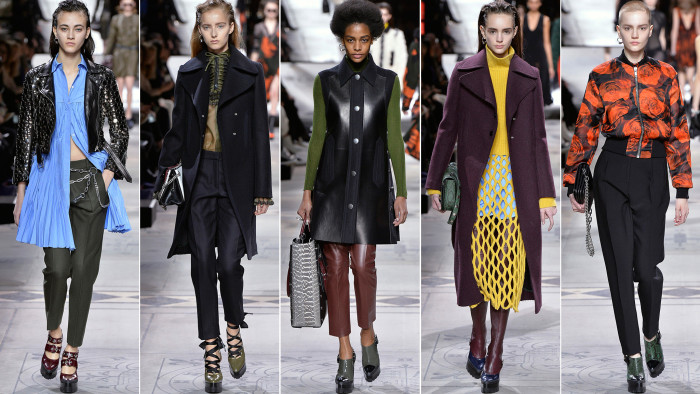Mulberry, Hill and Friends and Anya Hindmarch AW16 show report London Fashion Week

Simply sign up to the Life & Arts myFT Digest -- delivered directly to your inbox.
“Fashion just got friendlier,” remarked Emma Hill following her extremely perky five-minute film presentation to introduce Hill and Friends’ second collection, the accessories brand she launched with fellow Mulberry alumna Georgia Fendley, in September.
Six months later her team of 10 “or is it nine?” has redoubled their product offering to include a wider selection of small bags and leather goods and are finally taking wholesale orders. Their smiley-faced raspberry coloured brand of accessible luxury with “a sense of humour” (bags have cutie-pie names like “Tweency”, “Zippy” and “Happy”) is aimed at a woman who wants a “grown-up silhouette and bags with polish but does not take herself too seriously”.
It seems to have become a unique quirk of British design that our accessories must be fun. At Anya Hindmarch, which showed on the same day, bags were emblazoned with images of retro 1980s juvenilia: the primary-coloured squares of a Rubik’s cube and jagged, crab-like Space Invaders. Last season Hindmarch modelled her bags on high street signage, with bags from Boots and Mothercare.
But I have an issue with playful things. I am especially uncomfortable with playfulness being assumed as a national trait, as though for our appreciation of something lovely and sophisticated to be acceptable, it must necessarily be offset by infantilising it. I don’t like to clown around with accessories. They are too expensive to treat as toys. So I had high hopes for the first outing from the former Céline accessories designer Johnny Coca. The 40-year-old Spaniard was announced as the new creative head at Mulberry in November, following a ghastly period of profit warnings and stock collapse at the British luxury house. Could Coca and his new chief executive Thierry Andretta, return the house to its former standing? Might he bring new glamour to Mulberry? Early signs were confident: the company returned to profit last December but this first show, staged after a 30-month absence from the London schedule, was a chance to build some real momentum.
The Guildhall was certainly a grand enough setting to stage the next act. So were the show notes which cited Shakespeare and “the playwright’s capacity to replicate all echelons of society; from the noble to the nobody, the royal to the rebel” as inspiration. In fact, Coca’s greatest influence was the British street where he has been observing the tribes of London to find the new codes for the house. His new Mulberry was a bold one. Gone were the heritage details and quaint satchel-like offerings of yesteryear and here instead was a whole new look: Coca had even reintroduced an old Mulberry logo from the 1970s to announce it. There were at least 20 new bags, many embellished with hardware details and chain-link straps. He had taken the press studs of a biker jacket and used them to fasten handbags and totes designed for utility and versatility. A medium-sized “Djura” bag was sliced into pockets with zippered sections for maximum functionality. A caban bag was studded along bonded leather edges to pop open and refasten in alternative ways. Andretta has insisted Mulberry bags will be repriced between £500 and £900 in a bid to make them more accessible. There were many options here.
The clothing meanwhile echoed many of the same ideas: biker studs popped along the spines of a woollen cape and overcoat and were punched all over a leather biker jacket. The looks — part punk, part urban royal — featured pretty silky blouses, tulle and floral brocades mixed with mannish trousers and wool coats. Shoes were stack-soled with heavy treads and silver buckled straps. Some were worn with leather spats, all part of Coca’s attempt to emulate the English style of mixing it all up. Wear with, wear without; it is up to you. I wanted to like it far more than I did. I liked Coca and his desire to explain his love of British style and the eccentricities of our sartorial ticks. I believed that he felt Britain was “right” for him because it offered him “the freedom to design” and his longing to find “the value in a piece that demonstrated real technical function and quality”. But I spent a lot of time wishing he had just left stuff alone: why worry a lovely wool coat with so much white overstitching? Why stick studs where none will do?
So much embellishment seemed almost overcompensatory. Coca was employed from one of the great houses of minimalism, where he designed some of its greatest hits. There were achingly few of those elements here; a fantastic navy overcoat, the bib-fronted shirts, a string bag and matching string shift dress and a long glossy leather jerkin offered a tantalising glimpse of what could be. But maybe minimal is not right for Mulberry. Perhaps Coca has also understood the British luxury label as having to be quirky. Maybe, as Hill said, British fashion does need to be more friendly and eccentric. And maybe our “playful” sense of fun is in fact our greatest export. Let’s see how the numbers roll.
Photographs: Catwalking.com
Comments